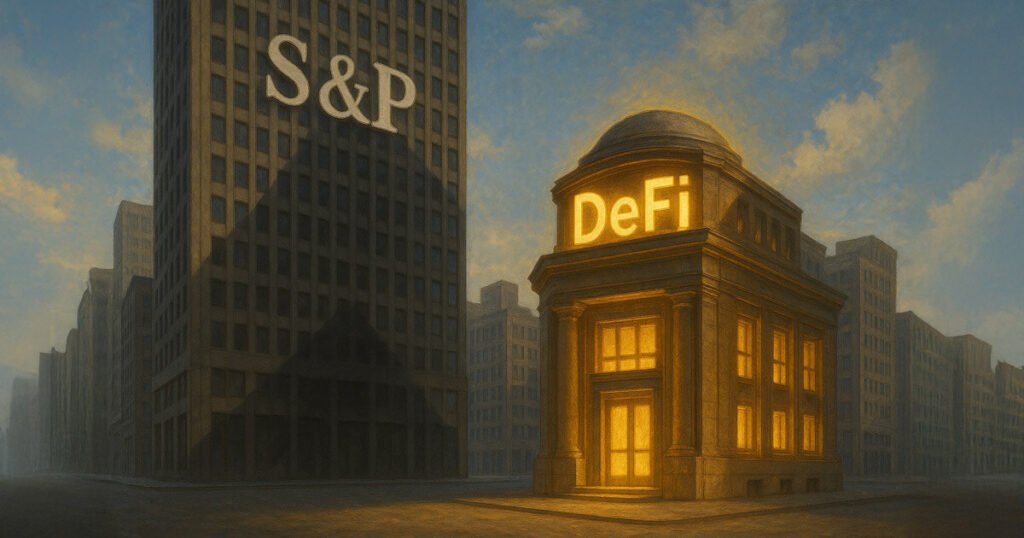S&P Global Ratings Assigns First Credit Rating to Sky Protocol: What It Means for DeFi
In a pioneering move for the decentralized finance (DeFi) sector, S&P Global Ratings has issued its debut credit rating for a DeFi protocol, assigning Sky Protocol a B-minus with a stable outlook. This groundbreaking rating, published on August 8, specifically refers to the protocol’s stablecoin liabilities—including USDS and DAI—and their interest-bearing derivatives. However, it’s important to note that this rating does not cover Sky Protocol’s governance tokens. The action signifies a major step towards integrating traditional credit evaluation methods with blockchain-based entities, potentially reshaping the landscape of decentralized finance.
The rationale for the speculative-grade rating provided by S&P is multifaceted. One major concern is depositor concentration, where a limited number of participants hold a disproportionately large share of the assets. Additionally, governance centralization is another red flag; founder Rune Christensen retains approximately 9% of governance tokens, coupled with low voter participation rates in governance decisions. This scenario raises alarms about the decision-making process and the overall health of the ecosystem. Furthermore, the protocol’s risk-adjusted capital ratio is reported at just under 0.5%, a figure that markedly falls short of conventional credit standards, amplifying worries about regulatory and cyber vulnerabilities.
S&P’s assessment equates Sky Protocol’s credit profile to that of the sovereign debt of the Republic of Congo, clearly placing it within speculative territory. The agency maintains a stable outlook, anticipating that the existing risk factors will remain consistent over the next year. For any potential upgrades to occur, there would need to be significant improvements in governance decentralization, capital adequacy, and a broader diversity among depositors.
Despite these challenges, S&P also acknowledged some operational strengths within Sky Protocol. Since its inception in 2020, the protocol has managed to operate with minimal credit losses. It holds diversified liquidity reserves that encompass fiat-backed stablecoins and tokenized assets, coupled with external audits of its smart contracts. While these factors provide a supportive framework for the rating, they are ultimately overshadowed by the significant concentration and structural risks identified.
S&P’s venture into protocol-level ratings is noteworthy, following previous assessments of stablecoins such as USDC, which received a "strong" rating, and USDT, rated as "constrained." This extension of rating frameworks to encompass the comprehensive liabilities of a DeFi protocol offers institutional counterparts—such as prime brokers, insurers, and structured product arrangers—a standardized method for evaluating credit risk. As a result, these ratings could influence how DeFi yields are priced, allowing for adjustments based on credit risk profiles instead of being dictated solely by supply and demand within the protocols.
The establishment of recognized credit benchmarks within the DeFi sector paves the way for more institutional engagement. Regulated entities focusing on risk management are often obliged to adhere to minimum rating thresholds, and S&P’s credit rating for Sky Protocol could fulfill such guidelines. However, it is crucial to note that according to S&P’s published methodology, the rating is unlikely to shift in the short term. Substantial reforms in governance and capital allocation, however, could alter this course in the future, thus integrating a formal risk framework into DeFi operations and providing a common reference for both decentralized players and traditional financial institutions looking to explore this burgeoning sector.
In summary, the assignment of a credit rating to Sky Protocol by S&P Global Ratings marks a pivotal moment in the evolution of decentralized finance. While there are risks and concerns that require attention, the operational strengths and potential for future improvements could signal a bright future for the protocol and the broader DeFi ecosystem. This development not only reflects the growing convergence between traditional finance and blockchain technology but also emphasizes the importance of robust risk assessment frameworks in facilitating institutional involvement in the DeFi space.


